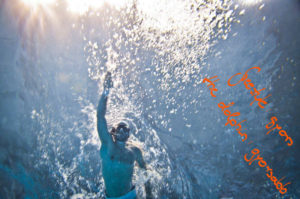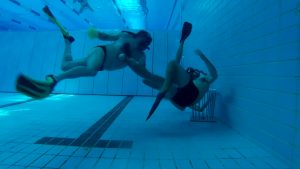The Swedish tactics, written by Henrik Stewenius, is like a Bible for underwater rugby players.The concepts laid down here define how underwater rugby is played, viewed and discussed. The main principles are the 3 roles of the game, goalie, defender and attacker, and that these roles are played by pairs of players, so 2×6 players in the water should mean 2×3 players underwater, and 2×3 players at the surface at any given time during a match.
This is what I was taught back in 2010, along with the importance of secure ball handling, so the ball was to be carried locked between your body and arm, in a similar manner like you see the egg-ball carried in regular rugby.
I’ve felt like the Swedish tactics are perfect tactics for an experienced and disciplined team to follow, but in the beginning, our club had irregular training times with only a few newcomers. To provide some real rugby experience, we played on a 5x8m area (basically the deep end of 2 lanes) which worked surprisingly well in any scenario. Not only does it allow a match to be played regardless of the number of players, but this is also the fastest way to teach rookies the dynamics of the game.
The reason behind that is simple, when people join a club, they rarely find beginner’s sessions. They are likely to float around during games for a long time, as they always see someone else going for the ball. Plus if they get a pass, they are easy to tackle, so it’s always a decision for any player: should I pass to the new player who’s likely to loose the ball or should I make the pass that’s safe for our game? Take away half of the players, and you’ll gradually increase the learning speed of a rookie. Same goes for the field: a shorter distance to the goal means less chance to have the ball stolen on the way. You get more goals scored, but the weaker team is more likely to get lucky every now and then. And we all know the difference between a 9-0 and a 14-2.
The first question rookies ask goes like this: “what should I do?” For the very first time, just try to remember which goal is which, and go for the ball. Everyone starts off as an attacker, with the exception of freedivers, who can and should play goalie first!
But when the goals are 8 meters away, the classic roles don’t mean much. What matters the most is the sequence and timing of the players diving. It boils rugby down to a constant dilemma of taking a risk or playing it safe.Let me make this clear with an example.

Say your squad of 3 consists of a strong, experienced player, a rookie and you, whatever level you may be. Your best chance is to have a good sequence. Since the goals are only a kick away, the best player needs to take position by the goal right away to avoid a sudden goal. Then should the rookie go, which will most likely be an attempt to tackle, and you should go third. You may be doing a counterattack or just exchanging the goalie who took the first dive. This should depend on the development of the situation, with the same things you assess at a regular game, like where’s the ball and who’s in possession, where are the other players, are they fresh on air or just about to surface, etc.
Choosing when and where to dive is instinctive for experienced players, but it is a result of internal calculations of possible payoffs. 3vs3 games help clear this question for rookies. Sometimes it’s enough to have just one player underwater, sometimes you need two, but then you’ll be down to one player for sure afterwards, and your opponent can exploit this mechanism the same way you can. Players in a 3vs3 game need to be able to recognize when 2 players are needed and respond to it quickly, without messing up the sequences of exchanging for air. This is where the importance of risk assessment comes in, in a similar manner how player attitudes define player roles for Swedish tactics.
But this viewpoint of risk-taking comes in handy when looking at normal matches too, especially powerplay. Take a risk or play it safe? This is the question if you get into ball possession. Is it better to rush to the opponent’s goal before their defense catches up, or you’re likely to get tackled on the way, and the ball should be kept passed around till the defenders make a mistake and the proper player can score a goal?
Or analyze defense the same way: should you opt to tackle your opponent midway, head towards the goal, or maybe for air and/or exchange? You have a great number of factors to compute in a flash. And having an instinct for this is only half-success because it needs to be shared with your teammates.
3vs3 not only shines the usefulness of an almost mathematical approach to games armed with game theory, it can also lead to quite different tactics worth exploring. What if you set up 2 trios, one mainly responsible for scoring (being in front) and one mainly responsible for defending the goal. Exchanges are still done in pairs, shifting from 3×2 to 2×3 does not mess that up. This leaves a bit more freedom for the players to react to different situations. During matches, you should see the number of players on the surface and underwater as a constant due to the duos playing the 3 different roles. But that’s rarely the case. Under heavy attack, you don’t just see a double-decker at the goal, but 2 defenders and a goalie at least. The same goes for attacking, it’s often a 3 man job to get the ball in. This is how risk analysis comes into play, as both teams need to carefully select the moments when they need to fortify their attack or defense in order to score a goal or prevent one. But to do all this, you got to know your opponent. That’s a topic for another post.



